 The citation in the bottom of the image accompanying this post really isn’t in proper Evidence Explained format. It has the key elements, although I did fail to include the fact that it was a digital image that was originally accessed. Some may say that’s “common sense” from where the item was obtained, but that’s a topic for another post.
The citation in the bottom of the image accompanying this post really isn’t in proper Evidence Explained format. It has the key elements, although I did fail to include the fact that it was a digital image that was originally accessed. Some may say that’s “common sense” from where the item was obtained, but that’s a topic for another post.
It’s “image cropped from original” that I want to address.
I modified this image.
I didn’t correct the spelling of any names and I didn’t remove any names from the listing. What I did do however was to remove the other pictures from the row in which Mom’s picture appeared. The intent here was not to deceive or “leave out something crucial.” I simply wanted to have a smaller image.
I think that my citation should note that I’ve altered the image because I have. It’s not like the original. It is two separate parts of the original placed together. What I did with this image was not the same as simply taking a part of it and reproducing that portion of the image as a smaller image. Genealogists do that on a regular basis, particularly with records that include information on several families, many of whom are unrelated. Other genealogists “rearrange” items from newspapers when articles are spread over several columns or several pages. That doesn’t really alter the content either–usually.
And it’s not the same as using various lightening and darkening features to enhance an image. Genealogists do that as well. That’s not really altering what is on the image either and could be considered like taking another picture with better lighting.
Removing the others from the year book image of my mother doesn’t change what this image communicates. The people are shown alphabetically, it’s not as if they are in family groups and I’ve not altered any impression of family structure by removing the others. But I’m starting to think that whenever I perform any editing of this type on a digital image, I should mention that editing in my citation.
So that others know that what they are seeing is not the original.
And now that I think about it, using “image cropped from original” really isn’t accurate here either so I need to improve upon that phrase.
Scott Eisenhuth says:
Great topic for discussion. I also do this all the time to save space and make the information more understandable.
For example I might have ancestors near the bottom of a census form but the column headings explaining what the information below means is at the top of the page. So I “cut” the form in Photoshop and move my ancestor’s information up to meet the column headings. To make this edit obvious I use a paper rip effect (adds a jagged edge to simulate a rip int the paper) on the area to the bottom of the headings and and an effect that Photoshop calls “stroke” to the edge of that section of paper. The stroke effect essentially adds a black edge of border to the level that it has been added to.
So the ripped paper effect and the black edge border should make it known that this is a section of paper that did not originally come just above my ancestors information. To also help, I make sure to include the row numbers of the census. Again another clue that an edit was made. Finally I add text to the graphic I have just made indicating the source information. Then I add a last line to the source saying: “Graphic By: Scott Eisenhuth.”
I send send an image if you’d like to see an example.
I will enjoy seeing what others say about this topic and how they handle it.
Thank you for posting this great topic. Scott Eisenhuth
mjnrootdig says:
Scott-Go ahead and send it to me at mjnrootdig@gmail.com–if you don’t mind me posting it. Thanks!
Michael